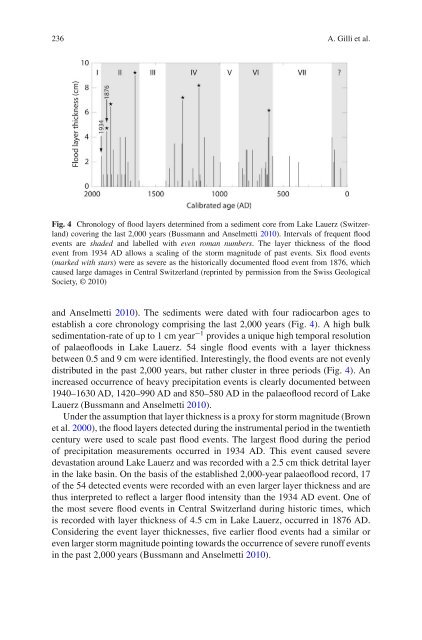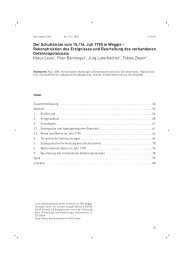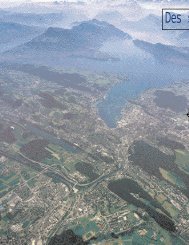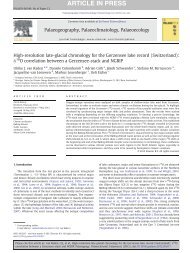Lake Sediments as Archives of Recurrence Rates and ... - Eawag
Lake Sediments as Archives of Recurrence Rates and ... - Eawag
Lake Sediments as Archives of Recurrence Rates and ... - Eawag
You also want an ePaper? Increase the reach of your titles
YUMPU automatically turns print PDFs into web optimized ePapers that Google loves.
236 A. Gilli et al.<br />
Fig. 4 Chronology <strong>of</strong> flood layers determined from a sediment core from <strong>Lake</strong> Lauerz (Switzerl<strong>and</strong>)<br />
covering the l<strong>as</strong>t 2,000 years (Bussmann <strong>and</strong> Anselmetti 2010). Intervals <strong>of</strong> frequent flood<br />
events are shaded <strong>and</strong> labelled with even roman numbers. The layer thickness <strong>of</strong> the flood<br />
event from 1934 AD allows a scaling <strong>of</strong> the storm magnitude <strong>of</strong> p<strong>as</strong>t events. Six flood events<br />
(marked with stars) were <strong>as</strong> severe <strong>as</strong> the historically documented flood event from 1876, which<br />
caused large damages in Central Switzerl<strong>and</strong> (reprinted by permission from the Swiss Geological<br />
Society, © 2010)<br />
<strong>and</strong> Anselmetti 2010). The sediments were dated with four radiocarbon ages to<br />
establish a core chronology comprising the l<strong>as</strong>t 2,000 years (Fig. 4). A high bulk<br />
sedimentation-rate <strong>of</strong> up to 1 cm year 1 provides a unique high temporal resolution<br />
<strong>of</strong> palae<strong>of</strong>loods in <strong>Lake</strong> Lauerz. 54 single flood events with a layer thickness<br />
between 0.5 <strong>and</strong> 9 cm were identified. Interestingly, the flood events are not evenly<br />
distributed in the p<strong>as</strong>t 2,000 years, but rather cluster in three periods (Fig. 4). An<br />
incre<strong>as</strong>ed occurrence <strong>of</strong> heavy precipitation events is clearly documented between<br />
1940–1630 AD, 1420–990 AD <strong>and</strong> 850–580 AD in the palae<strong>of</strong>lood record <strong>of</strong> <strong>Lake</strong><br />
Lauerz (Bussmann <strong>and</strong> Anselmetti 2010).<br />
Under the <strong>as</strong>sumption that layer thickness is a proxy for storm magnitude (Brown<br />
et al. 2000), the flood layers detected during the instrumental period in the twentieth<br />
century were used to scale p<strong>as</strong>t flood events. The largest flood during the period<br />
<strong>of</strong> precipitation me<strong>as</strong>urements occurred in 1934 AD. This event caused severe<br />
dev<strong>as</strong>tation around <strong>Lake</strong> Lauerz <strong>and</strong> w<strong>as</strong> recorded with a 2.5 cm thick detrital layer<br />
in the lake b<strong>as</strong>in. On the b<strong>as</strong>is <strong>of</strong> the established 2,000-year palae<strong>of</strong>lood record, 17<br />
<strong>of</strong> the 54 detected events were recorded with an even larger layer thickness <strong>and</strong> are<br />
thus interpreted to reflect a larger flood intensity than the 1934 AD event. One <strong>of</strong><br />
the most severe flood events in Central Switzerl<strong>and</strong> during historic times, which<br />
is recorded with layer thickness <strong>of</strong> 4.5 cm in <strong>Lake</strong> Lauerz, occurred in 1876 AD.<br />
Considering the event layer thicknesses, five earlier flood events had a similar or<br />
even larger storm magnitude pointing towards the occurrence <strong>of</strong> severe run<strong>of</strong>f events<br />
in the p<strong>as</strong>t 2,000 years (Bussmann <strong>and</strong> Anselmetti 2010).


